Brightening up a landscape with growing yellow shrubs in your garden is a great idea. Yellow-leafed shrubs, flowers, or berries add a burst of vibrant color to green leaves. Evergreen yellow bushes continue to offer some brightness even on dreary, gloomy winter days. Furthermore, yellow bushes may disguise unsightly garden features such as brown fences.
In your garden or yard, landscaping with yellow blooming or foliage bushes may create stunning visual effects. Full sun, partial shade, ground cover, or adding visual height are all characteristics of yellow-flowered shrubs. Moreover, several yellow-blooming shrubs grow well in a variety of soils.
Do you want to add bold and vibrant yellow hues, texture, height, and fragrance to your garden landscape? Try looking for good landscaping shrubs. The greatest yellow shrubs for your yard are described and photographed in this article.
How to Choose Yellow Shrubs For the Landscape
USDA growing zones, sunlight, soil types, and the shrub’s growth habits must all be taken into account when selecting yellow landscaping shrubs. To keep bright golden yellow hues, certain yellow bushes or variegated types need at least six hours of daily sunlight.
Which shrubs with yellow foliage or flowers may be planted in your yard is usually determined by your growing zone. Yellow evergreen shrubs, for example, thrive in sub-zero temperatures. Other heat-loving plants, like as Florida, thrive in semi-tropical conditions.
How to Identify Yellow Shrubs
The form of the leaves, growth style, and color of the stems and leaves are all characteristics that you can use to differentiate yellow bushes. On gray, brown, or yellow stems, yellow leaves might be heart-shaped, oval, or pointed and develop in pairs or alternately. Thorns, flower bud color, and form are also possible identifying characteristics of yellow shrubby plants.
Evergreen Yellow Shrubs (With Pictures) – Identification Guide
Evergreen yellow bushes are a great way to add bursts of vivid yellows to your garden all year. Juniper, Chinese privet, and arborvitae cultivars are the best yellow shrubs with evergreen foliage. Green and bright yellow evergreen foliage can also be found on variegated wintercreeper and holly shrubs.
Gold Mop Cypress (Chamaecyparis pisifera ‘Golden Mop’) – Small Yellow Shrub

The bright-yellow ‘Golden Mop’ cypress is a dwarf evergreen shrub with golden evergreen foliage that forms a conical or rounded mound. Over the winter and spring, the slow-growing, hardy coniferous shrub features bright golden-yellow threadlike leaves. Even in summer, the attractive yellowish-green colors of the dwarf yellow conifer shrub remain. After ten years, the ‘Golden Mop’ cypress can grow up to 24 inches (60 cm).
The little yellow plant may reach a height of 5 feet (1.5 meters) and a width of 1 foot (30 millimeters). The yellow Gold Mop cypress thrives in full sun or light shade and is ideal for growing in USDA zones 4 to 8. As a foundation plant, specimen plant, or container shrub, drought-tolerant shrubs perform well.
Chinese Privet (Ligustrum sinense ‘Sunshine’) – Dwarf Shrub With Yellow Leaves
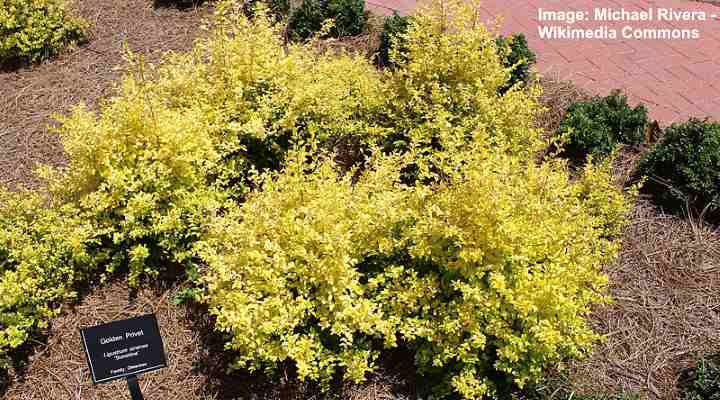
To brighten up your garden, the compact Chinese chartreuse, yellowish-green chartreuse leaves on reddish-brown stems adds a burst of sunny yellow color. Little white summer blooms give way to glossy blue-black berries in the fall, and the dwarf evergreen shrub blooms with them.
Throughout the year, the golden-yellow tiny leafy plant retains its visual appeal. The Chinese privet cultivar ‘Sunshine’ grows to be 3–6 feet (0.9–1.8 meters) tall and wide, growing up to 4 feet (1.2 meters). In USDA zones 6 to 9, this ‘Sunshine’ Chinese privet has the brightest yellow colors. It thrives in full sun. As a little privacy hedge, shrub border, or to perk up a container garden, the low-maintenance dwarf shrub is ideal.
Wintercreeper (Euonymus fortunei ‘Emerald ‘n’ Gold’) – Bright Yellow Evergreen Shrub

Little evergreen shrubs with golden yellow and green variegated leaves add a beautiful touch to any garden landscape. In a garden landscape, green oval leaves with golden borders brighten up shaded areas. The small, ground-hugging yellow shrub may grow to be 1–2 feet (0.3–0.6 meters) tall and 4 feet (1.2 meters) broad, depending on the cultivar.
USDA zones 5 through 9 are the best places to grow Wintercreeper. The bright yellow shrub is a good shade ground cover plant because it thrives in shaded settings. It’s also suitable for front-of-house planting, driveway edging, or a tiny hedge since it has a low growth rate. The vigorous climber Wintercreeper will quickly cover a wall or fence with golden yellow and green leaves.
All Gold Shore Juniper (Juniperus conferta ‘All Gold’) – Dwarf Evergreen Shrub With Yellow Color

A tiny evergreen shrub with golden-yellow needle-like leaves, Gold shore juniper (Juniperus conferta ‘All Gold’) is a popular choice. The light, airy growth habit of the low-growing, spreading yellowish shrub makes it appealing. The shore juniper has year-round aesthetic appeal, from bright gold leaves in the spring to coppery-bronze leaves in the winter.
The low-maintenance, sun-loving evergreen plant grows to be about 1 foot (0.3 meter) tall and 8 feet (2.4 meters) broad, making it a excellent choice for evergreen ground cover. Furthermore, the shrub makes a excellent landscaping plant in front of the home, in rock gardens, or in pots due to its yellowish evergreen foliage.
Dwarf Golden Evergreen Arborvitae (Thuja orientalis ‘Aurea Nana’)
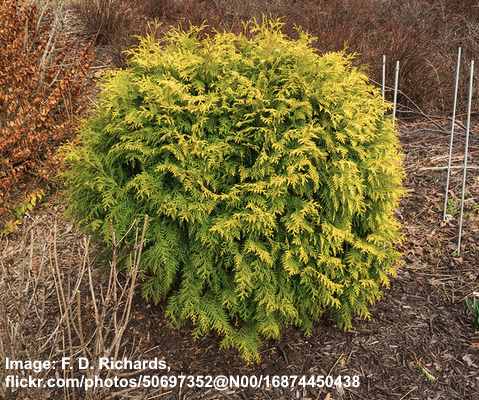
The dwarf golden arborvitae has upward growing stems with thick clusters of yellow-green leaves and is an evergreen shrub. The dwarf evergreen has a bushy growth habit and an oval shape overall. In the spring, the delicate needle-like feathery sprays are a vibrant yellow, while by winter, they have turned orange-yellow.
USDA zones 5 to 9 are ideal for sun-loving yellow arborvitae ‘Aurea Nana. The dwarf shrub is 3 to 4 feet (0.9 to 1.2 meters) tall and broad, growing up to 3 feet (0.9 meters). As a specimen plant, low-growing evergreen hedge, foundation plant, or line a pathway or driveway, you can grow the bushy conifer shrub.
False Cypress ‘Golden Charm’ (Chamaecyparis pisifera ‘Golden Charm’)
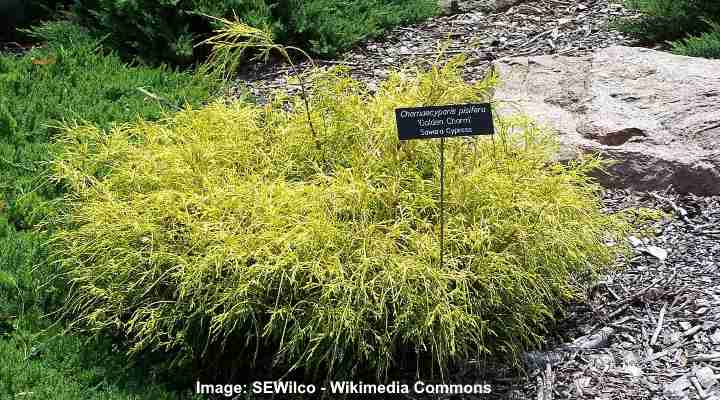
The Golden Charm false cypress is a compact coniferous shrub with soft, thread-like, bright golden-yellow needles that makes for excellent front of house landscaping. The semi-weeping branches of the attractive, mounding evergreen bush produce a shrub that resembles a mop head.
The bright greenish-yellow leaves of the lovely non-flowering evergreen shrub survive in full sun. False cypress ‘Golden Charm,’ a little maintenance dwarf shrub that performs beautifully as a specimen planting, shrub border, evergreen privacy hedge, or container plant. In USDA zones 4 through 8, the shrub thrives in full sun and well-drained moist soil.
Flowering Yellow Shrubs (With Pictures) – Identification Guide
In your garden landscape, brightening yellow blooms may provide a burst of golden hue and fragrant scents. To enhance biodiversity, landscaping with yellow blooming bushes will likewise attract pollinators to your garden. Yellow blooming shrubs are available here.
Oregon Grape (Mahonia aquifolium) – Thorny Yellow Flowering Shrub
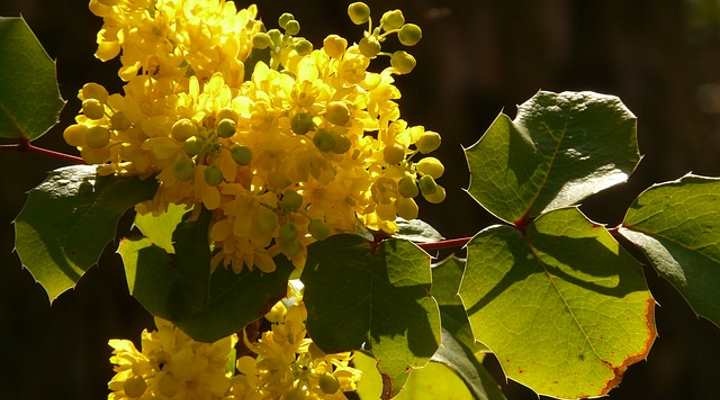
Oregon grape is a prickly shrub with blue berries that bloom in early spring and give way to yellow flowers. Cup-shaped little yellow blooms create huge flower heads with glossy green jagged leaves. On crimson stems, clusters of little grape-like blue berries develop when the golden-yellow blooms fade.
The upright to spreading habit of Illinois grape ornamental bushes. To thrive, the shrubs prefer partial sun or full shade in USDA zone 5 through 8 landscapes. Shade gardens, along north-facing walls, or as foundation plants may be used to grow the suckering shrub. The tall, slender yellow plant grows to 6 feet (1.8 meters) and 2 feet (0.6 meters) broad.
Compact Oregon Holly Grape (Mahonia aquifolium ‘Compacta’) – A Dwarf Evergreen With Yellow Flowers

Since of its continuous yellow blooms that bloom in the spring, the leaves of the compact Oregon holly grape are classed as evergreen. With clusters of bright yellow flower spikes that stand out against the dark green, leathery, lance-shaped leaves, the dwarf evergreen landscaping shrub blooms. Bunches of black blue berries follow the flowers.
USDA zones 5 through 9 include the Oregon holly grape ‘Compacta,’ which is a shade-loving ground cover. The broadleaf, slow-growing evergreen shrub may reach 3 feet (0.9 meters) tall and 5 feet (1.5 meters) wide in maturity.
Agarita (Mahonia trifoliolata) – Compact Shrub With Yellow Flowers
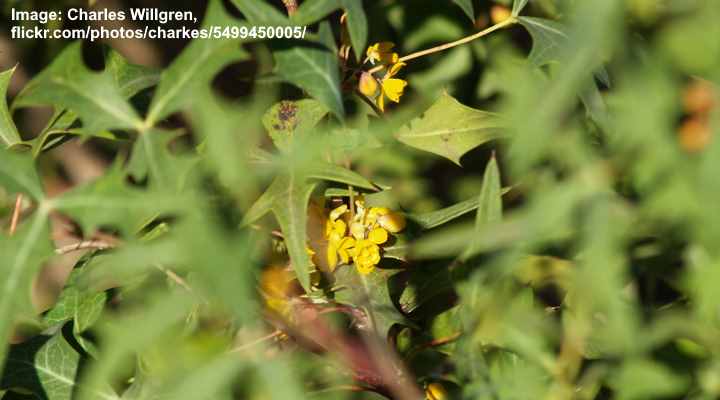
Agarita has prickly evergreen leaves, beautiful cup-shaped yellow flowers, and red berry-like fruit. It’s a spiky plant with prickly evergreen leaves. Early spring sees the buttercup-like golden blooms, which last through the summer. The yellow-flowered plant has gray-green holly-like barbed leaves and brilliant red edible berries in the autumn.
The plant grows 2 to 6 feet (0.6 to 1.8 meters) tall and broad. In USDA zones 7 to 9, agarita bushes thrive in full sun and relatively dry soil. As a security barrier, foundation planting, or slope planting, the thorny bush is ideal.
Small Flowering Potentilla Shrubs (Potentilla fruticosa)

Yellow-flowering potentilla shrubs grow to be 4 feet (1.2 meters) tall and have lovely five-petalled flowers. Late in the spring and into the summer, huge yellow blossoms bloom. Each 1.5″ (40 mm) wide sunny yellow blossom. The blossoms give the plant a yellow tint, which is remarkable.
USDA zones 3 through 7 are ideal for Hardy potentilla plants. They tolerate full sun to partial shade and grow best in average, moist soils. Informal hedgerows, specimen plants, beds, borders, and foundation plantings are all examples of potentilla shrub landscapes.
Yellow Flowering Hibiscus Shrubs (Hibiscus rosa-sinensis)

Several tropical hibiscus shrub types have enormous, trumpet-shaped yellow blooms that are yellow in color. The huge papery petals with a ruffled look of hibiscus flowers are readily identifiable. Double blooms with wavy petals or single blooms in the form of a funnel with a long protruding stamen are among the spectacular yellow shrub flowers available. Brackenridge’s rosemallow (Hibiscus brackenridgei) is one example of a yellow-flowering hibiscus shrub.
Tropical yellow blooms 6 inches (15 cm) across emerge from this shrub. A funnel with a deep pink core is formed by the rounded golden-yellow petals. Learn more about hardy hibiscus varieties that can tolerate harsh winters if you live in temperate regions.
Azalea Shrubs with Yellow Flowers

Deciduous or evergreen azaleas include a range of yellow flowering types, from which many are blooming all year. Red, orange, pink, white, or multicolored blooms may be found on azalea shrubs. Yellow-flowering azaleas are, however, the best option if you want to brighten up your summer garden.
Azalea shrubs range in height from 2 to 8 feet (0.6 to 2.4 meters) and have a comparable width, including ‘Golden Oriole,’ honeysuckle azalea, azalea Calendulaceum, ‘Klondyke’ azalea, and azalea ‘Narcissiflorum.’ The rounded form and thick, leathery leaves of the bushy shrubs are well-known. In USDA zones 4 through 9, azaleas are cold hardy. Before purchasing, you should determine the hardiness of each species.
Border Forsythia (Forsythia x intermedia)
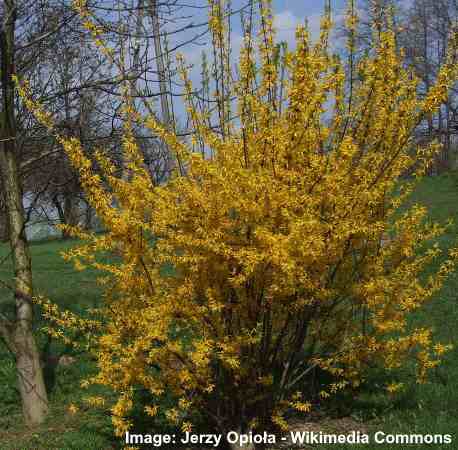
Forsythia is a tough shrub with bright yellow star-shaped blooms made up of thin, linear petals that makes an excellent choice for quick-growing informal flowering hedges. In spring and summer gardens, the yellow blooms cover the length of rising upwards stems, adding a bright yellow highlight.
The informal flower hedge or foundation plant is suitable for coastal gardens and thrives as a shrubby landscape Hedge. In USDA zones 6 through 9, full sun is required for the yellow border forsythia to flourish. It can grow to be 6–9 feet (1.8–2.7 meters) tall.
Witch Hazel (Hamamelis spp.)
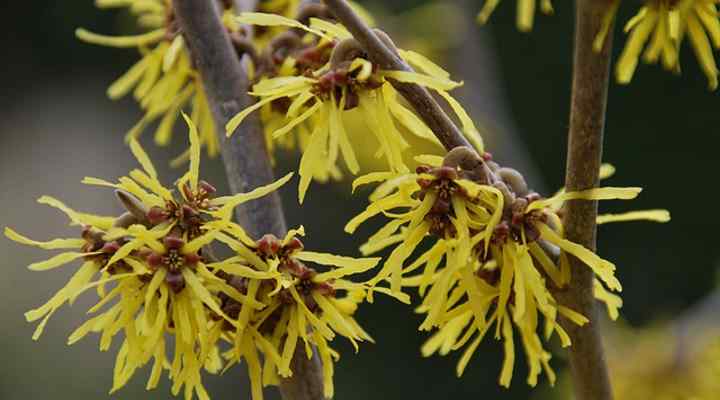
Witch hazel is a fragrant, hardy yellow-flowering shrub that blooms in the winter and has bare branches with yellow petaled blossoms. With spindly petals, lovely oval green leaves, and smooth, brown stems, the attractive yellow shrub is easily recognized by its yellow flowers.
As a screen, deciduous hedge, or specimen plant, plant it in full sun or partial shade. USDA zones 3 to 9 are ideal for witch hazel blooming shrubs, which reach 15 to 20 feet (4.5 to 6 meters) tall and broad.
Winter Jasmine (Jasminum nudiflorum)
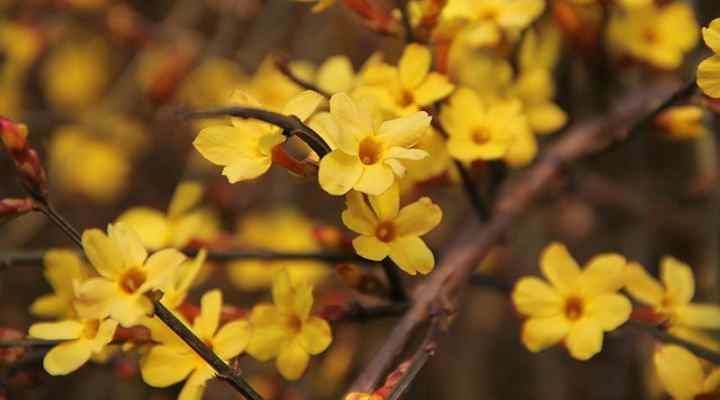
In late winter or early spring, the brilliant yellow winter jasmine produces little golden star-shaped blooms. Vining stems grow 4 ft. (1.2 m) tall and up to 15 ft. (4.5 m) broad on this attractive decorative hardy shrub. flowering winter jasmine develops as a spreading mound as a yellow shrub.
Winter jasmine may be grown as a specimen plant, in mass planting, or with its trailing vines cascading over a wall in USDA zones 6 through 9.
Deciduous Yellow Shrubs (With Pictures) – Identification Guide
Even if they don’t bloom yellow flowers, deciduous bushes provide yellow color, texture, and structure to the garden all year. Some of the finest deciduous shrubs for a garden landscape include yellow twig dogwood, witch hazel, and border forsythia.
Japanese Barberry (Berberis thunbergii ‘Bogozam’) – Shrubs With Yellow Leaves

The yellow-leafed shrub Bonanza gold barberry is a deciduous dwarf slow-growing plant that has yellow flowers. Tiny oval yellow leaves that turn pale yellow throughout the season make up the deciduous shrub, which has a compact, rounded growth habit.
In the spring, inconspicuous yellow blooms emerge, and in the autumn, red berries. The compact yellow shrub of the Bonanza Gold has tiny leaves sprouting profusely. The small-growing, low-lying landscape shrub may grow to be 3 feet (0.9 meters) tall and broad. In urban gardens, shrub borders, or cottage gardens, you may grow this low-maintenance blooming shrub. USDA zones 6 through 9 are ideal for Japanese barberry ‘Bogozam,’ which thrives in full sun to partial shade.
Sea Buckthorn (Hippophae rhamnoides) – Thorny Shrub With Yellow Berries

Sea buckthorn is a big, prickly shrub that is cold hardy and easy to maintain. The lovely shrubby plant bears yellowish-green blooms, long-lasting yellowish-orange autumn fruits, and slender willow-like leaves on prickly stems. Sea buckthorn plants reach 8 to 12 feet (2.4 to 3.6 meters) in height and breadth.
Sea buckthorn thrives in USDA zones 3 through 8, and is a cold-hardy shrub that can tolerate freezing temperatures. While the suckering shrub has a uneven development pattern, it may develop into a large informal hedge or coastal windbreak.
Yellow Twig Dogwood (Cornus sericea ‘Flaviramea’)
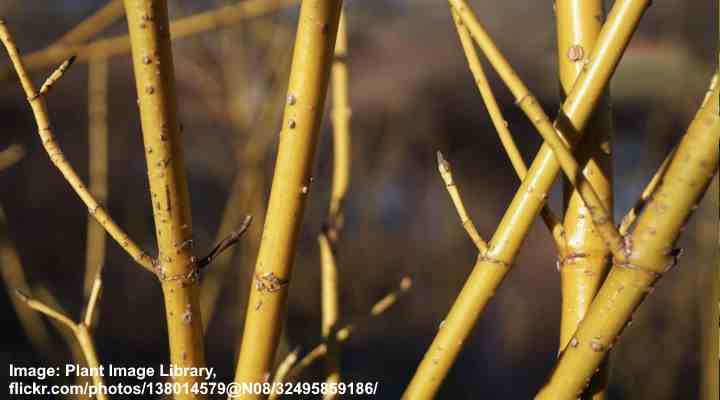
With its bright-yellow branches and greenish-yellow stems, yellow twig dogwood adds interest to a winter garden. In winter, the upright growing golden-yellow branches create vibrant thickets. The yellow bushes have dark green leaves in the spring and summer, but orange-red leaves in the fall.
The multi-stemmed shrub also has creamy-white spring blooms. USDA zones 3 through 8 are ideal for yellow twig dogwood plants. The upright bushes are 5 to 6 feet (1.5 to 1.8 meters) high. In the autumn and winter, the shrub stalks are golden yellow, while in the spring and summer, they are greenish-yellow.
